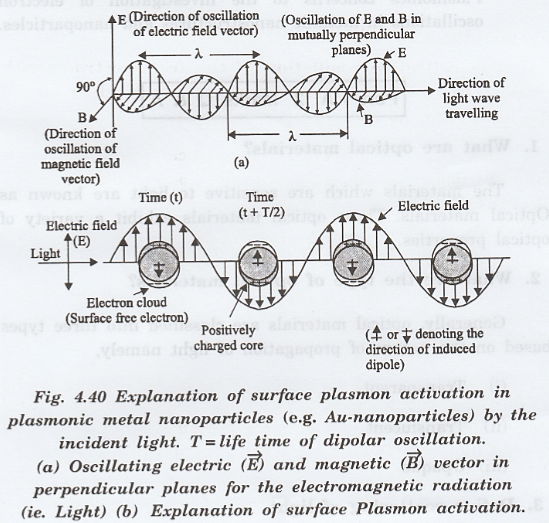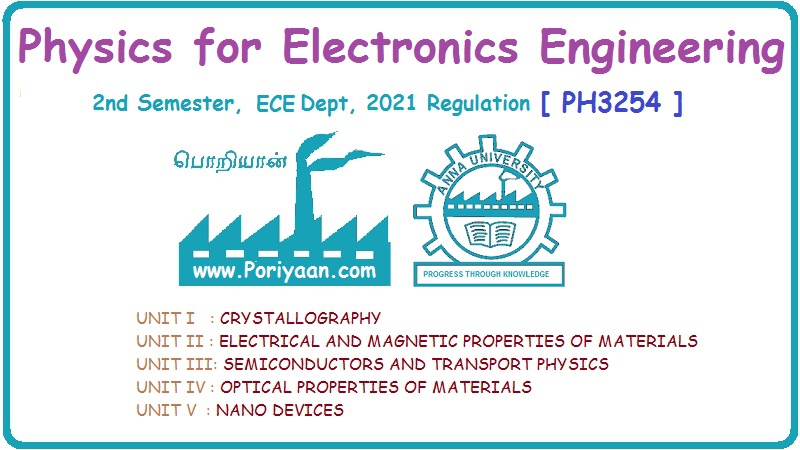Physics for Electronics Engineering: Unit IV: Optical Properties of Materials
Plasmonics
Principle, Uses, Surface Plasmon Resonance (SPR)
Plasmonics or nanoplasmonics refers to the generation, detection and manipulation of signals at optical frequencies along on metal-dielectric interfaces in the nanometer scale.
PLASMONICS
i.
Plasmonics or nanoplasmonics refers to the generation, detection and
manipulation of signals at optical frequencies along on metal-dielectric
interfaces in the nanometer scale.
ii.
Inspired by photonics, plasmonics follows the trend of 99 to miniaturizing
optical devices and find applications in sensing, microscopy, optical
communications, and bio-photonics.
iii.
Plasmon is the collective oscillation of conduction arrois electrons in metals.
The resonance energy depends on the particle size and shape, and the
permittivity (dielectric constant) of the surrounding materials.
Principle
Plasmonics
typically utilizes so-called Surface Plasmon Polaritons (SPPs) that are
coherent electron oscillations travelling together with an electromagnetic wave
along the interface between a dielectric (e.g. glass, air) and a metal (e.g.
silver, gold).
The SPP modes are strongly confined to their supporting interface, giving rise to strong light- matter interactions. In particular, the electron gas in the metal oscillates with the electro- magnetic wave. Because the moving electrons are scattered, ohmic losses in plasmonic signals are generally large.
It
limits the signal transfer distances to the sub-centimeter range, unless hybrid
optoplasmonic light guiding network, or Plasmon gain amplification are used.
Surface Plasmon Resonance (SPR)
The
collective oscillation of the free electrons with respect to the fixed
positions of the positively charged nuclei (acting as the core) is called
plasmon.
In
the case of a metallic nanoparticle where there is a large fraction of atoms as
the surface atoms, the free surface electrons can collectively oscillate to
produce the surface plasmon (SP). But due to the quantum confinement, the surface
plasmon is localized and it is called the Localized Surface Plasmon (LSP).
When
a nanoparticle is exposed to light, its oscillating electric vector of light
can induce a collective oscillation of free electrons of the metal
nanoparticles.
In
other words, the incident light can cause a oscillating a dipole moment. Thus,
this leads to charge separation generating a dipole oscillation along the
direction of the electric field of the light. Thus is explained for a spherical
nanoparticle in fig. 4.39.

For a particular nanoparticle, the amplitude of light induced collective oscillation of free surface electrons reaches maximum at a specific frequency of the incident light.
It
produces the surface plasmon resonance (SPR) and the light is absorbed (called
plasmon absorption).

In
other words, when frequency of the incident electromagnetic radiation matches
the inherent frequency of surface plasmon, SPR occurs and the light absorption
is observed. (Fig.4.41)
Uses of Plasmonics
i.
Plasmonic gold and silver nanoparticles have unique optical, electrical, and
thermal properties and hence are used in applications such as antimicrobial
coatings and molecular diagnostics. Color engineering.
ii. The unique optical properties of metal nanoparticles are very useful in color engineering,
iii.
Plasmonics (or nanoplasmonics) is a young topic of research, which is part of
nanophotonics and nano-optics. Plasmonics concerns to the investigation of
electron oscillations in metallic nanostructures and nanoparticles.
Physics for Electronics Engineering: Unit IV: Optical Properties of Materials : Tag: : Principle, Uses, Surface Plasmon Resonance (SPR) - Plasmonics
Related Topics
Related Subjects
Physics for Electronics Engineering
PH3254 - Physics II - 2nd Semester - ECE Department - 2021 Regulation | 2nd Semester ECE Dept 2021 Regulation
